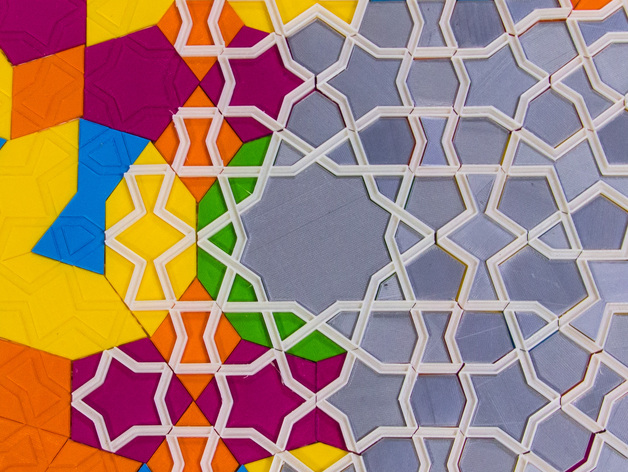
Girih Tiles for Interactive Islamic Designs
thingiverse
3D print and assemble your own classic Islamic-style artwork by using Girih tiles to build intricate woven strapwork! The tiling pattern in the photo is rotationally symmetric. On the left are the basic colorful tile shapes. Towards the middle we have started to add the overlaid strapwork, which is completely determined by the tiles. On the right, we added gray mosaic tiles to obscure the original tiles and reveal the strapwork pattern. Girih tiles are used in Islamic art and architecture to create intricate woven strapwork patterns. The underlying periodic patterns that create these designs are related to Penrose tilings and predate the formal mathematical discoveries of such tilings by at least 500 years. Photo by Guy Sie Print Settings Printer Brand: Ultimaker Printer: Ultimaker 2 Rafts: No Supports: No Resolution: .15mm Infill: 10% Notes: We needed to print hundreds of tiles to bring to SXSW Interactive, so the printing was split up between four printers: an Ultimaker 2+, an Ultimaker 2, an Ultimaker 2Go, and an Ultimaker 2 Extended+. To make the most interactive model we printed the tiles, strapwork, and mosaic pieces separately and in different colors, so that Girih patterns could be assembled using the three steps outlined below. How to make Girih patterns You can create your own Girih designs with 3D-printable tiles, strapwork lines, and mosaic pieces, in three steps. Step 1: Make a tesselating pattern with the five basic tile shapes - pentagons, decagons, rhombi, bowties, and irregular hexagons. Step 2: Each tile determines a strapwork pattern that passes through the midpoints of its edges. These strapwork patterns match up across all the tiles to make a woven design. Step 3: Cover up the original tiling by placing mosaic pieces between the strapwork lines to reveal a beautiful Girih design. What files are included? The following models are available for each of the five Girih tile shapes: Plain tiles - no strapwork Tiles with plain or fancy strapwork attached (switch filament for 2-color prints) Tiles with etched recesses to hold separately-printed strapwork pieces Snap-in plain or fancy strapwork pieces Mosiac pieces for adding at the last step, to cover up the original tessellation shapes Download the demo files to print Girih tiles, strapwork, and mosaics with 40mm side lengths. Or use the Customizer if you want to change style, size, or clearances. You can also download the OpenSCAD file if you want to remix the code. Learn more Basic information about Girih tiles Girih Tiles, from Wikipedia Girih, from Wikipedia Girih Tile Math, from the blog "it's a clean machine" Online Girih pattern construction apps Girih Designer Girih App Books about Girih tilings and Islamic art Islamic Geometric Patterns, by Eric Broug Islamic Design: A Genius for Geometry, by Daud Sutton Upper-level articles and resources Ancient Islamic Penrose Tiles, Science News 3/1/2007 Medieval Islamic tiling reveals mathematical savvy, by New Scientist 2/22/2007 Decagonal and Quasi-Crystalline Tilings in Medieval Islamic Architecture, by Peter J. Lu and Paul J. Steinhardt, Science 2/23/2007 1-hour lecture on Decagonal and Quasicrystalline Tilings in Medieval Islamic Architecture, by Peter J. Lu ===== Twitter: twitter.com/mathgrrl Hacktastic blog: www.mathgrrl.com/hacktastic Shapeways geekhaus store: www.shapeways.com/shops/mathgrrl This design and all associated pictures and files are licensed under the Creative Commons Attribution Non-Commercial Share Alike license. If you want to use designs, images, or files outside of the terms of this license, please email request@mathgrrl.com.
With this file you will be able to print Girih Tiles for Interactive Islamic Designs with your 3D printer. Click on the button and save the file on your computer to work, edit or customize your design. You can also find more 3D designs for printers on Girih Tiles for Interactive Islamic Designs.
